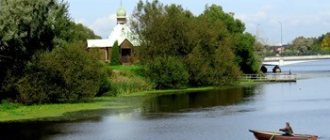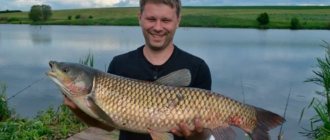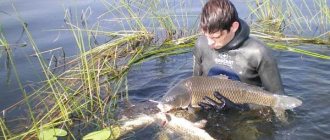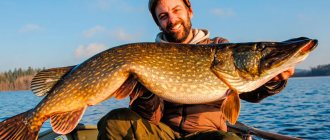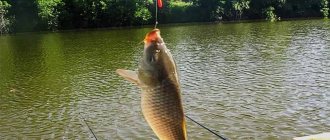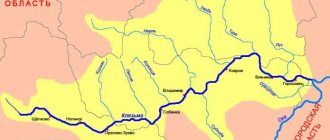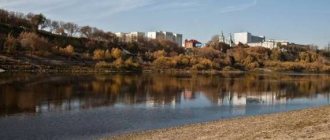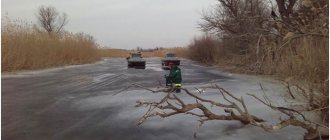Briefly about the reservoir.
The beginning of the Khoper River is 12 springs located near the village of Poperechnoye, which is located in the Penza region. The total length of the river is approximately 1000 km. This is the leftmost tributary of the Don, which passes through the Penza, Saratov, Voronezh, and Volgograd regions. Many tributaries flow into it; the main rivers are the Vorona, Buzluk, and Savala. The total area of Khopra is about 61 thousand km. The river has an average width of 40 m, and in some places it reaches 100 m and even 200 m. The reservoir is not deep, mostly 1.5 m, in rare places the depth reaches 10 m.
There are small towns and villages near the reservoir, the main ones being: • Balashov; • Uryupinsk; • Povorino; • Borisoglebsk; • Novokhopyorsk.
Features of the Khoper River
In late autumn the river freezes until the weather warms up in April. The flood is accompanied by an increase in the water level by 5 m in the main part of the river, and in the lowlands the level can rise by 8 m. This lasts approximately 2 - 2.5 months. In summer, the river becomes shallow, revealing numerous spits and islands. The rise of water begins with the onset of autumn during heavy and frequent rains.
In the Khopra floodplain there are many lakes, some of which stretch for several kilometers. The area below Borisoglebsk is considered the most hilly. The right bank is high with many hills and ravines. The left one is lower with many sandy beaches, and there are many fallen trees in the riverbed. Along the entire length of the river there are mixed forests, and in the lower part they are mainly oak. The forests contain wild pears, cherries and apple trees.
The most favorable time for vacation is in May and August, when there are no large concentrations of mosquitoes and there is no intense heat. The water in Khopra is one of the cleanest in Russia, and you can see the bottom at a depth of up to 2 m. In the upper part of the river you can see little shipping. There are several small dams on the river.
Seasonal fishing features
Interesting fishing on the Khopyor River is possible throughout the year. The main components of effective fishing are the correct choice of gear and baits, as well as the ability to “read” a body of water.
Spring
Spring is the best time for fishing on Khopra for a variety of white fish. From mid-April, a good bite begins here for the following representatives of the ichthyofauna:
- roach;
- silver bream;
- white-eyes;
- subusta;
- ide;
- chub.
Roach, silver bream and white-eye are caught in the spring using a Bolognese float rod, which allows you to quickly fish a large part of the water area.
On a note! In conditions of strong current, which is typical for the river at this time of year, the most effective equipment is called a “tug”, which ensures the bait slowly floats at the very bottom.
The best bait for this time of year is a dung worm. This is explained by the fact that during seasonal floods a large number of arthropods end up in the water and the fish quickly get used to high-calorie food. Good bait significantly increases the number of bites. It is imperative to add heavy soil to the mixture to prevent its rapid erosion.
For spring fishing for podust on Khopra, medium-class feeder tackle is optimal. This representative of the carp family likes to stay on the main stream, so the weight of the feeder used should be at least 60 g. Of all the animal baits, this fish prefers maggots.
A small crank-type wobbler is one of the best baits for spring chub fishing on the Khoper.
The active spring bite of ide and chub on the Khoper River is due to the massive emergence of insects, which form the basis of the food supply for these fish species. At this time, fly fishing gear works great. When fishing with a spinning rod, it is better to give preference to the following types of bait:
- rotating lures of dark color;
- small, floating crank wobblers;
- small twisters on a light jig head;
- streamers;
- various silicone imitations of aerial insects.
Spring fishing is good because the fish bite is not tied to a specific time of day and can last throughout the day.
In early May, the Shemaya enters Khopyor from the Don. This fish feeds in the upper layers of water. It is caught with both float and fly fishing gear. Miniature spinning baits also show good results.
Reference! In spring you can catch small fish on the river. This fish often sits on the hook when fishing for podust or roach. The average weight of pecking specimens is about 400 g.
About fish.
Khoper is rich in various species of fish, among which you can find: catfish, pike, perch, bream, crucian carp, roach, bleak, pike perch, ide, chub, asp and other smaller fish. Large pike can be found in the Saratov region. Mostly it reaches a weight of 1 kg or more. The most popular among fishermen is the area near the village of Vasilievka, which is located below the city of Borisoglebsk in the Voronezh region. The bite will be successful from the beginning of September until the first frost. At this time, there is no suffocating summer heat, and the fish begins to gain weight before wintering and the bite is more frequent.
Species composition of ichthyofauna
Fishing on Khoper is always very exciting and unpredictable, which is largely due to the large species diversity of underwater inhabitants. In the river you can catch:
- roach;
- silver bream;
- white-eye;
- bream;
- crucian carp;
- subusta;
- bleak;
- saberfish;
- ide;
- chub;
- pike;
- pike perch;
- asp;
- soma;
- perch
Rarer angler trophies include burbot, carp, tench and gudgeon. Sterlet has almost completely stopped appearing. In spring, species such as vimba and shemaya enter the river.
Khoper
The Khoper River is the largest left tributary of the Don and the second largest among all tributaries of the Don, second only to the Seversky Donets. The Khoper River flows through the territory of the Penza, Saratov, Voronezh and Volgograd regions of the Russian Federation. According to UNESCO, it is one of the most environmentally friendly rivers in Europe. According to legend, the river got its name from the name of a miller who combined the water of 12 springs into one stream and built a water mill, where he ground grain for his fellow villagers for many years. There is even a monument to grandfather Khoper at the source of the river. The mill is also shown to tourists, but the guides usually find it difficult to answer whether it is the same mill. The source of the river is located in the Penza region on the Volga upland. The river flows in a southwestern direction and near the village of Ust-Khoperskaya it flows into the Don. The Khopra basin is located on the Russian Plain, which largely determines the flow and character of the river and its banks. The average depth of Khopra is 7-8 meters. Its length is almost 1000 km. The width in the middle reaches ranges from 20 to 35 meters. In the river valley there are wetlands and lakes. In the lower reaches, the width of the channel reaches 70-120 meters, and its depth increases to 10 meters.
The flow of the river has a large number of sandy and clayey rifts; in the riverbed there are rocky areas, whirlpools, and debris of snags. There are many ditches and oxbow lakes along the banks, many of which are connected to the main channel only during floods. In many places the river bed forms bends and backwaters. The banks of the river are covered with dense vegetation. The right bank is steep and rocky. Along the left bank, flat areas are interrupted by elevated and sometimes steep areas. There are quite a few access points to the water. So it’s better to go fishing by boat in order to reach secluded places rich in fish by water. The river is fed predominantly by snow. The duration of the spring flood is more than one and a half months. The river opens up from ice at the beginning of April and freezes at the end of November. During warm winters, ice cover can be unstable. The low water level with the lowest water level is established by the beginning of July. Periodically it may be interrupted by rain floods. A stable rise in water is expected in the autumn months, when cold weather does not contribute to active evaporation. The main tributaries of the Khoper River are the Vorona, Olshanka, Kamzolka, Serdoba, Pasha, Dobraya, Buzluk, Akulovka and many others. In the lower reaches of the Khoper there is the Khopersky Nature Reserve, as well as the Almazovsky and Arkadaksky reserves, where a number of rare species of wild animals are under state protection.
For lovers of ethnography
Those who are interested in ethnography can visit the festival “Cossack Walk on Khopra”, which is held annually in early August in the city of Balashov. The holiday usually takes place over two days: the first is dedicated to performances by creative groups from Prikhoperye. The second day takes place in the village of Nikolevka, Balashovsky district, on the right bank of the Khopr. It is dedicated to demonstration performances of the Cossacks, horse riding, the ceremony of initiation into the Cossacks and the Cossack wedding ceremony. The ethnographic museum-estate “Nikolyevskoe Settlement” is also located there. In Balashov itself it is worth visiting the local history museum and the “House of Merchant Dyakov”.
We recommend reading: Where does the Sinichka River flow on the map of Moscow, geography of the river, fishing
Fishing Features
You can get to settlements located along the banks of the Khoper River by roads, by train and by boat. The river is navigable in the section from the city of Novokhopersk to its confluence with the Don. There are many places on the river where there are bridges connecting the right bank with the left. It is almost impossible to get a good catch in places where there are convenient approaches to the river. Firstly, because vacationers gather there during the hot season. And secondly, there is high fishing pressure. But it’s enough to sail a boat just 1 km away from crowded places, cast a fishing rod, and the fishing situation changes for the better. From June to early October, the problem for anglers who prefer bottom gear is the grass that is carried by the current. Without knowing local conditions, it is quite difficult to fish from the shore in close proximity to snag debris. The most catchy places are considered to be backwaters located at the bends of the river, as well as the confluence of large tributaries. Fishing in oxbow lakes and lakes located along the banks of the Khoper can be productive.
Kayaking
Even a novice tourist can go kayaking from the source to the mouth. According to the classification of tourist routes, the Khoper River belongs to category 1 of complexity, that is, the lowest. The best time for rafting is May-September. You can start rafting already in the upper reaches of the river, near the village of Sekretarka (Penza region). There are still small obstacles: flooded trees, destroyed dams, low road bridges, sandbanks. In some areas it is impossible to navigate a kayak on water; you only have to go around the obstacle on land. After the confluence of the Vorona, the Khoper becomes much wider, and nothing prevents rafting.
In places where the channel is wide, the flow is calm and leisurely; As the river narrows, the flow speed increases. Beautiful scenery, convenient parking and swimming areas allow you to fully enjoy an active holiday.
When approaching the Khopersky Nature Reserve, you must remember that the river is closed for rafting on rubber boats and kayaks from March to June. More detailed information can be found by visiting the reserve's website. By the way, the reserve itself offers ecological routes for kayakers throughout its territory.
We recommend reading: What river is Murom on and the significance of the Oka for the city of the Vladimir region
Fishing on Khoper
A striking example of a reservoir where there is a lot of excellent fish, but how difficult it is to catch them is the Khopra section, below Borisoglebsk near the villages of Vasilievka and Alferovka, in the Voronezh region, where I and my friends traveled a lot, loving these places for interesting fishing.
Excellent depths 4-5m below the city attract with the intrigue of catching large fish, but it is in these holes that the bite is especially capricious, both predator and bream. Due to the dominant depths, which are atypical for Khopr, the fish react very poorly to any rise in water, so during periods of prolonged rains, fishing does not go well, as a rule. The most interesting thing begins with the fall of the spring flood, usually in the second half of June.
The second peak of the bite occurs in the second half of September - early October, but again only when the water is low - just a little something is wrong with the level, everything seems to be “cut off” immediately, especially bream. On other rivers the fish are somehow more responsive to changes in water level, but here they react well only to a fall. Moreover, it is not a fact that as the level rises, whiteness tends to shallower depths.
It happens exactly the opposite. In the pits near Vasilievka, the bottom fish are usually caught from the right access bank, and often simply not reaching the bream (you can see from the echo sounder that the bream are standing above the far edge), only when casting 50 m away do the bites begin. However, long-distance feeder casts may intersect with the interests of trackers, who can hook bottom rigs with wobblers, and you won’t be able to attack too much.
So boat feeder fishing on Khopra is more successful, calmer, and more reliable. Moreover, the echo sounder often notes a greater density of bream on the left bank - an order of magnitude less crowded, where it is more relaxing to fish. In general, with a boat, the bream is king on this section of the river. It is important that the boat does not tie you to any place, but simply provokes you to look for fish when there are no bites. And flocks are often found by poking.
After all, often, at first glance, very promising bottom changes found by an echo sounder do not work at all - for some reason, not only bream, but no fish at all. At the same time, on some flat ground it is possible to detect schools of active bream.
Active search boat strategies are also good with a float rod. At times, retrieving is excellent for catching bream with a long release of the float, especially in fairly deep (4-5 m) riffle areas. Probably, these outbreaks of zhora are associated with the intersection with running flocks. But in any case, the bite wanes everywhere as the water rises, when the bream scatters, staying mostly high above the bottom, and it is not clear how to catch it.
In warm, stable weather, fishing is good even in high water near grassy shores; they are also found here - short grassy spots overgrown with water lilies and about one and a half meters deep. It is impossible to catch large whitefish in such places by swooping, although there may be a lot of crucian carp, rudd and even tench here, and only skillfully caught by local floaters, who feed their places for a long time.
There are enough Khopra and catfish in this area, including trophy ones, as I myself have been convinced of more than once. Moreover, the maximum concentration of this fish is in an area not exceeding 5-6 km, although this does not make life particularly easy for the catfish - everyone knows where the catfish are, but try again! Apparently, the area has been pressed down in recent years, this is clearly noticeable by the fact that the kwok is working less and less.
And good fish are caught less and less by trolling from the end, you have to carefully select certain wobblers, your own unique methods, not forgetting to put your luck in the boat...
As for pike perch, it is ubiquitous; it is caught almost within the boundaries of Borisoglebsk and below. It happens that it’s very cool in late autumn to take it higher than the city, where there is less pressure on fish and the fishing is better. And at other points of the river, the best time for pike perch is pre-winter, when truly trophy specimens weighing 5-7 kg pass by.
